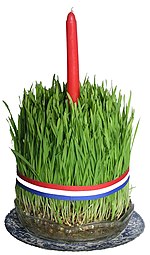Badnjak (Croatian)

Badnjak (Croatian pronunciation:
With increased urbanization and migrations to cities, the badnjak tradition has recently been limited to more rural areas, as many urban homes do not have a hearth or fireplace, increasing the risk of a fire hazard, along with the fact that it is near impossible to cut one's own log in the city. Instead, some may choose to have a symbolic log kept in the home.
Etymology
The term badnjak comes from the old Slavic words bodar or badar, which means "to be awake" (bdjeti).
Origins

There are many interpretations for the meaning of the badnjak, but scholars agree that it is a remnant of
Preparation

Among Croats of the Roman Catholic faith, Christmas Eve begins on December 24. Early in the morning, traditionally before dawn, the father or another male of the household goes into the forest to chop a piece of log, usually from an
When evening comes, the badnjak log is placed in the hearth. In
The Badnjak must last all evening and in many regions, it is burned again. In certain regions, it is re-lit in the New Year on the Feast of The Three Kings and sometimes it stays by the hearth until Lent, where it serves as a special log upon which other logs are placed. In the villages, the ashes or charred fragments of the badnjak are scattered in the fields to assure a fruitful crop.
Celebration

Much like other European countries, Croatia has specific traditional celebrations that go along with the felling and lighting of the badnjak. The day is spent in preparation for Christmas, with the home being decorated and the feast for the next day being prepared, and all chores must be done before the ringing of the church bells and the lighting of the badnjak. The

Another old tradition is sowing
Throughout the day, the woman of the house prepares the Christmas meal, which usually consists of many courses and desserts. Traditional foods include lamb, roasted pig,
Since Christmas Eve is a fasting day, the family only has a small meal at dinnertime. For Badnjak supper, baklar (
See also
- Badnjak (Serbian)
- Yule log
- Roman Catholicism in Croatia
References
- ^ http://www.zupa-svkriz.hr/duhovnost/krozgodinu/hrvatski_bozic1.htm Archived 2010-01-07 at the Wayback Machine Zupa Sv. Kriza: PRIČA O NAŠEM HRVATSKOM BOŽIĆU
- ^ Stories Behind the Great Traditions of Christmas, by Ace Collins; p. 191
- ^ Christmas in Ritual and Tradition, Christian and Pagan, by Clement A. Miles, p.252-253
- ^ http://www.kbf-st.hr/Casopisi/CUS_2008_1.htm#DRVO_BADNJAK_U_KR%C5%A0%C4%86ANSKOJ_TRADICIJSKOJ_KULTURI_Marko_Dragi%C4%87,_Split Archived 2009-03-02 at the Wayback Machine Katolicki bogoslovni fakultet-Split, Marko Dragić: DRVO BADNJAK U KRŠĆANSKOJ TRADICIJSKOJ KULTURI
- ^ The Magnificat Advent Companion by James Monti
- ^ Christmas customs and traditions, their history and significance, Clement A. Miles, p. 252
- ^ The World Encyclopedia of Christmas, y G. Q. Bowler
External links
- Croatian Badnjak (in Croatian)
- Božić u Hrvata Archived 2013-12-06 at the Wayback Machine (in Croatian)
